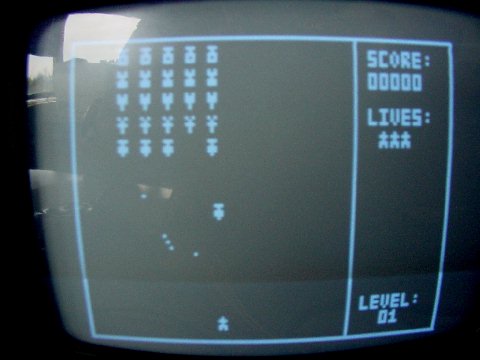
Single player game
Despite having to change from using an LCD panel to a TV, the project was a major success. The modified TV generation code
lets us draw many characters to the screen in one frame without any artifacts or other TV glitches. The gameplay is fast, smooth, and enjoyable thanks to the speed of the TV code.
The game state is updated every frame with careful attention to the order of
events in order to provide good concurrency. The game responds immediately and appropriately to button presses of the gamepad.
The measured power consumption of the circuit running from the 9V battery is
approximately 30 mA.

Single player game
The video signal timing is pretty good, but does not entirely correspond to the RS-170 standard. The standard requires 63.55 uSec/line, however Bruce Land's TV code runs at 63.625 uSec/line. The deviation does not create a noticeable difference in the TV signal, and generates black and white TV excellently. The collision detection for both player and enemy bullets works as desired. The AI for a ship that has broken formation, simple
as it may be, functions properly. From our testing, the game runs as expected. However, due to the nature of software, there may still be bugs in the code, but hopefully they do not affect gameplay.
The main safety concern we have with using a TV as the output for our game is the possibility of causing epileptic seizures. The nature of television signal generation makes this possible, but only as likely as any other television uses. To prevent seizures from occurring as much as possible, our game does not contain any flashing screens (besides the refreshing of the TV screen) or flashing animations. Also, our circuit does not contain any dangerous parts, except maybe some sharp leads on the bottom of the solder board, possibility of lead poisoning from the solder, and risk of electric shock, but these are minimal.
Other projects in the lab did not interfere with our circuit (at least not noticeably).
It is unlikely that our circuit interfered with other projects. The only sources of interference in our circuit
would be noise from from the MCU oscillation and the generation of the TV signal.
Our project is very usable for just about anyone. The interface is simple and does not require any special knowledge. To play the game, all that is necessary is being able to see the TV screen and pressing the buttons on the controller.